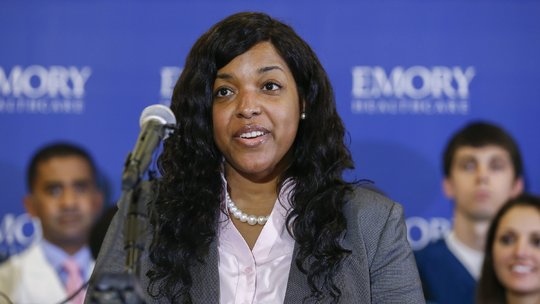(CNN) — For a disease that kills more than 50% of its victims abroad, Ebola in the United States is getting snuffed out at a remarkably fast rate.

When Dr. Kent Brantly became the first U.S. patient with Ebola in August, he was hospitalized for 19 days.
On Tuesday, when the most recent American patient, nurse Amber Vinson, was discharged, she’d been in the hospital for just 14 days.
Her colleague, Nina Pham, also went home after just 14 days.
So the question is, why did our patient recover so quickly? said Dr. Bruce Ribner of Emory University Hospital in Atlanta, where Vinson was treated.
The honest answer is we’re not exactly sure.
But he and other health experts have several hypotheses:
Younger patients recover faster
Vinson, 29, and Pham, 26, were among the youngest patients treated in the developed world.
We know from a lot of data coming out Africa that younger patients do much better than patients who are older, Ribner said.
But unlike West Africa, where Ebola has killed closed to 5,000 people, Americans have the distinct advantage of better nutrition. If an infected patient getting proper care normally has a strong immune system — and younger patients generally do — the chance of survival goes up.
The virus was aggressively attacked
Of the nine Ebola patients treated at U.S. hospitals, eight have survived. And all of those released have something in common — they were treated at one of the country’s four hospitals that have been preparing for years to treat a highly infectious disease like Ebola.
The sole fatality in the United States — Thomas Eric Duncan — was not treated at one of those facilities.
The general dogma in our industry in July was that if patients got so ill that they required dialysis or ventilator support there was no purpose in doing those interventions because they would invariably die, Ribner said.
I think we have changed the algorithm for how aggressive we can be in caring for patients with Ebola virus.
Speed matters
This may seem obvious. But sometimes it’s the basics — namely, the ability to pump ample fluids through patients with severe diarrhea and vomiting — that can mean the difference between life and death.
The most important care of patients with Ebola is to manage their fluids and electrolytes, to make sure that they don’t get dehydrated, said Dr. Tom Frieden, director of the Centers for Disease Control and Prevention. And that requires some meticulous attention to detail and aggressive rehydration in many cases.
When he first arrived at Texas Health Presbyterian Dallas Hospital, Duncan was sent home with antibiotics. He wasn’t admitted for another three days.
Brantly and Writebol became symptomatic while they were still in Liberia — and they had to be flown here, spurring a slight delay in treatment.
The rest were quickly tested and quarantined as soon as a low-grade fever was detected.
Transfusions may have helped
Most of the American patients received blood or plasma transfusions from other survivors. The plasma contains the antibodies necessary to fight the virus.
Brantly donated plasma to at least three patients — Pham, Dr. Rick Sacra and NBC freelance cameraman Ashoka Mukpo. All three survived.
It’s very fortunate that the three patients I’ve been able to donate to, they and I share the same blood type, Brantly told CNN’s Anderson Cooper.
There was some controversy about why Brantly didn’t give plasma to Duncan, who eventually died. But health official said the two did not have the same blood type.
Dr. Craig Spencer, the only Ebola patient still being treated at a U.S. hospital, recently received a transfusion from Nancy Writebol, one of the first American survivors.
Experimental drugs may have helped too
Duncan received experimental medicine six days after admission to the hospital. It was a far longer wait than four other Ebola patients treated in the United States. Those patients got experimental medicine immediately.
Experts, however, say the jury’s out on the effectiveness of these drugs.
Protective wear reduces exposure
The relatively swift recoveries of Vinson and Pham might also be attributed to their personal protective equipment (PPE) they were wearing when they treated Duncan.
While some nurses at the Texas hospital reportedly complained about PPE that left their necks exposed, at least both were suited up.
(Vinson) was wearing personal protective equipment during the care of her patient in Dallas, and therefore it is quite likely that the amount of virus she was exposed to was substantially less than what we see in patients who get infected in less developed countries, Ribner said.
And we also know that the higher the viral load that you get infected with, the more severe your disease is likely to be.





